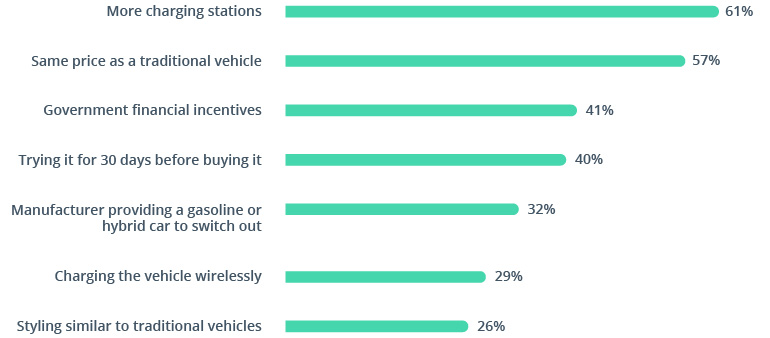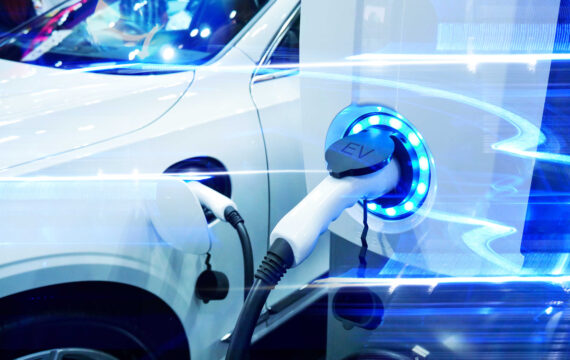In the automotive context, the potential of electrification is huge. Electric cars offer countless benefits to both drivers and the environment. Even considering the ecological footprint from the production of an electric vehicle (EV) and the generation of electricity to power it, an electric car is much more environmentally friendly than its conventional counterparts. Nevertheless, no innovation is all benefits. Electrification has its challenges.
This article will explore the main electrification challenges and show how an automotive UI development solution can help address them.
Electrification challenges
Though the benefits of electrification are indisputable and global EV sales show 40% year-over-year growth, more than 97% of all vehicles sold are traditionally fueled. Why are drivers still so hesitant about buying an electric car?
According to a survey conducted for Volvo, high vehicle costs and mileage limits due to insufficient charging infrastructure are two of the main reasons why many drivers aren’t joining the electrification trend.
Source: Volvo Reports — The State of Electric Vehicles in America
Range anxiety is less of a concern for EV drivers, who are more focused on price.
Source: Volvo Reports — The State of Electric Vehicles in America
Poor charging infrastructure
Unfortunately, Volvo’s findings are not groundless. Even in California, the most EV-mature state, there’s only one charger for every ten EVs. Besides, since most stations have Level 2 chargers, it takes 8 to 10 hours for one full charge.
On the one hand, this doesn’t seem like a big deal. The average EV owner drives 29 miles a day, within the range of any EV (average ranges are between 150 and 250 miles), and most EV owners can charge the vehicle at home. On the other hand, charging at home doesn’t work for long-distance travelers and people living in apartments, since most parking garages don’t have EV charging capabilities.
Given that, building out networks of charging stations is vital. The bad news is that OEMs can’t handle this challenge on their own. Assistance from authorities is needed. Still, an EV route planner built into an in-car infotainment system can considerably reduce the level of range anxiety and add more certainty to the EV driving experience.
Price
Electric vehicle prices range between $30,000 and $40,000, which is far more expensive than the average gas-powered vehicle. The main reason is costly battery production. Though modern EVs run on traditional rechargeable batteries of the type used for laptops and mobile phones, they’re much bigger (to hold more energy). They thus require more materials for their production, including lithium, cobalt, nickel, and magnesium — all of which are expensive.
And though buying an EV may lead to significant cost savings, those savings aren’t tangible at the point of purchase. As the infographic below suggests, price parity with traditional vehicles would increase the likelihood of buying an EV among 57% of Volvo research respondents.
Source: Volvo Reports — The State of Electric Vehicles in America
EV manufacturers should look for ways to lower vehicle prices to compete with traditional OEMs.
Automotive HMI design
The issue of human machine interface (HMI) design is not generally covered in EV surveys. Still, the problem persists among all modern OEMs: Only 56% of drivers are satisfied with their car’s human machine interface. What’s more, as other research suggests, 49% of drivers say their infotainment system is a distraction. Given that, we can assume that OEMs sometimes neglect usability in their attempts to stand out from the competition.
The trick is that in the automotive industry, a UI’s role is not limited to improving the driving experience. It’s also about safety. Interacting with a digital cockpit might distract drivers from driving. Thus, OEMs should strike a balance between functional complexity and ease of use, which is possible with the help of the following HMI design principles:
- Features. The focus should remain on functionality that ensures the safe and successful completion of the driver’s primary task. Only then should manufacturers proceed with additional features.
- Text. Text should be precise, comprehensive, stay within one line, and not be smaller than 5.3 to 6mm. At the same time, HMI designers should avoid text where possible and use graphics instead.
- Interactions. A driver should be able to perform a desired action in a series of eight 1.5-second glances. For that, easier types h of interactions are required (single taps, flipping right/left/up/down, scrolling with a snapping effect, etc.). Also, it’s recommended to enable interactions with a system without user input.
- Colors. Though from the safety viewpoint, dark mode is a must, it shouldn’t be the only
option — a light mode is preferable, for example, for reading maps. Besides, “traditional” colors and high contrasts ensure better visibility.
As you can see, design plays a central role in the context of automotive HMI development. Unfortunately, in many teams, a UI/UX expert has limited control over the product’s design. Perhaps this is the main reason why most automotive HMIs are still far from perfection.
How does Kanzi help overcome these challenges?
There’s no denying that the problems described above are too complex to be overcome with a single solution. Still, there’s a technology that can empower OEMs on their way to higher EV sales, and it’s called Kanzi. Kanzi is a one-stop solution from Rightware for streamlined design and development of HMIs for automotive and other industries that use embedded systems.
Kanzi offers a set of out-of-the-box features to streamline each aspect of HMI development, from UI creation to deployment. It consists of two parts:
- Kanzi Studio — a tool for UI creation
- Kanzi Runtime — an engine for execution and deployment of Kanzi UI designs on target devices
Besides that, Kanzi comes with a set of tools (Kanzi Connect, Kanzi Performance Analyzer, etc.) and various plug-ins (Kanzi Maps, Kanzi Particles, Kanzi Stereoscopy, Kanzi Safety, etc.) that accelerate development, leaving more room for creativity and innovation.
What Kanzi can do

Source: Kanzi
All in all, the Kanzi UI solution stands out to HMI designers and engineers in many ways. With Kanzi, they can:
- Build designs quickly with ready-to-use UI design elements and layouts to create working prototypes for anything, from a head-up display (HUD) to a mobile app
- See changes in real time and visualize and interact with UI designs without waiting for engineers to write the code
- Gain complete control over their designs throughout the entire HMI development process since visual data and logic exist separately
- Import assets including fonts, images, and 3D files with animation capabilities from all leading design platforms and mix 2D and 3D seamlessly
- Create animations
- Enable various user input methods
- Leverage a variety of content localization and internationalization capabilities
- Use a built-in graphics rendering engine instead of developing and maintaining their own
- Focus on software development instead of UI coding since all UI elements are ready to use
- Reuse designs and code across projects
- Extend standard Kanzi functionality with plug-ins
- Run Kanzi-based in-car UI designs on Android, Windows, and all leading automotive operating systems
- Integrate Kanzi UIs with other tools and processes effortlessly
Though this list already looks impressive, these are not all the capabilities of the Kanzi UI solution. You can learn more about Kanzi on the Rightware website.
How can Kanzi help with EV challenges?
Given all the benefits listed above, it’s clear why more than 15 leading OEMs and over 10 Tier 1 companies have chosen Kanzi. But how does it perform in the context of the EV challenges we’ve discussed previously? Let’s see.
HMI design
In the automotive domain, UI design is a matter of safety, not just a smooth and enjoyable user experience. That’s why in terms of automotive HMI development, the role of the UI designer is central.
With visual design, data, and app logic existing separately in the Kanzi settings, designers can control their designs and make changes on demand throughout the development process without interfering with engineering. This not only promotes synergy between designers and developers but increases the chances to build a genuinely intuitive HMI.
Price
You might be wondering what HMI development has to do with EV prices if the latter largely depend on battery production. But HMI development costs money too. Since an HMI development team isn’t limited to a single software engineer and one hour of development, you might find yourself paying a fortune where you didn’t expect to.
One of the main reasons many OEMs choose Kanzi is that it considerably reduces the coding hours thanks to its ready-to-use UI components, plug-ins, code reusability capabilities, and Model–View–ViewModel architecture, which allows designers and developers to work in parallel.
Thus, Kanzi accelerates your time to market while reducing the cost of HMI development.
Poor charging infrastructure
In the previous paragraph, we’ve mentioned an embedded EV route planner as an efficient way to alleviate the effects of poor charging infrastructure. With Kanzi Maps, you can build such a navigation solution faster and more easily without sacrificing quality.
Kanzi Maps is a map rendering plug-in for the easy creation of spectacular navigation experiences. The tool works seamlessly with any map provider. It offers a set of must-have mapping features such as 2D/3D modes, customizable themes, zoom in/zoom out, real-time rendering, full routing capabilities, and easy integration in the automotive HMI.
On top of that, it allows you to design maps in the same Kanzi UI workflow. This means you can leverage the full potential of Kanzi to create an EV routing planner that truly improves the daily EV driving experience.
How does Intellias use the Kanzi framework to develop intuitive HMIs for EVs?
Kanzi is a powerful tool for the streamlined creation of next-gen car UI designs. However, merely adding Kanzi to your HMI development tech stack doesn’t mean you’ll unlock its full potential. Profound knowledge of the framework is required. And at Intellias, we can provide you with that level of Kanzi expertise.
As an official Kanzi partner, we know the ins and outs of the Kanzi framework. This allows us to deliver a full spectrum of Kanzi HMI development services, from consulting and planning to release and maintenance.
Besides, we constantly explore Kanzi’s potential. One of our most recent proof of concept (PoC) deliverables is a Kanzi-based navigation routing framework that displays the optimal EV route based on available charging stations and the battery level. Another of our PoC deliverables is a Kanzi-based multimedia solution that offers an enjoyable yet safe in-car multimedia experience. Both solutions are much more cost-effective than their counterparts and seamlessly integrate with the Kanzi UI workflow.
Whether you want to develop an EV route planner or in-car multimedia solution or plan to build a Kanzi UI in a car from scratch, contact us. We’ll help you take your customers’ EV driving experience to the next level.


